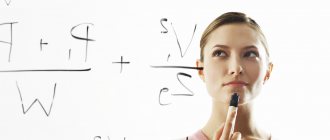Socionics. Nowadays, there are many techniques that help a person better understand himself and those around him, allowing him to navigate life more effectively and solve both personal and professional problems with greater productivity. It is also interesting that, albeit infrequently, new concepts appear. Socionics, which is relatively young and increasingly popular today, offers an interesting typology of personality, as well as the possibility of practical application in life of knowledge about oneself and other people.
Socionics: a brief history and overview of the basics
Socionics is a special concept of personality types and the relationships between them. It appeared in the 70s of the 20th century, and its creator was the Lithuanian sociologist Ausra Augustinavichiute. The main ideas of this concept were outlined in her work “On the Dual Nature of Man” in 1980.
Socionics
The basis for the creation of socionics was the typology of psychotypes of the Swiss psychiatrist Carl Gustav Jung, as well as the theory of information metabolism of the Polish psychiatrist Anton Kempinski. From the latter, Augustinaviciute took the idea that the human psyche “feeds” on information signals, thereby activating information metabolism.
But Jung’s typology, which describes eight psychological types, is of greatest importance for socionics:
- Thinking (introverted and extroverted)
- Feeling (introverted and extroverted)
- Sensation (introverted and extroverted)
- Intuition (introverted and extroverted)
Jung also identified one more characteristic - a psychological attitude - introverted (directed “inward”) or extroverted (directed to perceive the outside world). It is with this in mind that each of the four main psychotypes is divided into two (introverted and extroverted).
In addition, thinking, feeling, sensation and intuition are also the main mental functions, to each of which two additional ones can be added - sensation and intuition. With their help, you can more accurately describe the human psyche (you can read more about the ideas of the Swiss psychiatrist in our article “The Ideas of Carl Gustav Jung”).
Initially, Jung's typology was not intended to classify people, but after some time, based on his ideas, tests were born that made it possible to classify people by type (for example, the Myers-Briggs questionnaire, the Gray-Wheelwright test and others), and, naturally, socionics.
Augustinaviciute gave the mental functions of Jung’s theory (in his theory these were quantitative characteristics of mental processes) the form of “variants of information metabolism.” She also suggested that in the process of perceiving the surrounding reality, the human psyche uses eight discrete (interrupted) socionic functions:
- Logic (corresponds to Thinking in Jung's typology). It is divided into introverted or structural (denoted) and extroverted or business (denoted).
- Ethics (corresponds to Feeling in Jung's typology). It is divided into introverted or relational ethics (denoted) and extroverted or emotional ethics (denoted).
- Sensory (corresponds to Sensation in Jung's typology). It is divided into introverted or sensory sensations (denoted) and extroverted or volitional (denoted).
- Intuition (corresponds to Intuition in Jung's typology). It is divided into introverted or intuition of time (denoted) and extroverted or intuition of possibilities (denoted).
Each socionic function perceives one specific “aspect” of information that comes from the outside world. Based on this, the extent to which a certain socionic function is developed affects a person’s ability to understand the relevant aspects of the surrounding reality. And here we need to return to information metabolism.
From the position of socionics, the flow of information that the psyche perceives and processes, in the process of information metabolism, is divided into eight aspects corresponding to each of the functions and processed by it. Socionics is based on the fact that each personality type perceives and processes information aspects in its own way, based on the difference in the development of a particular function. Socionic functions are mental elements that help a person interact with information aspects.
Thus, socionics studies the laws by which the psyche of each of us perceives and processes information relating to the entire diversity of the surrounding world. Using this model, we can make predictions about the actions of other people, establish their qualities and potential, and understand what can be expected from them.
The basis of socionics is modeling and systems approaches. However, due to insufficient empirical validity (according to some experts), it has not yet been recognized as science. Not belonging to either the field of sociology or the field of psychology research, socionics has been and remains an independent field.
In addition, all the criteria for determining the socionic type (sociotype) of a person were established mostly speculatively. Therefore, determining and verifying the results of psychological typing present some difficulties from a scientific perspective. It is for these reasons that socionics is considered as a direction or teaching, and not as a science (we will talk about criticism later).
Despite this, many famous psychologists fully share the ideas of socionics. Among them are A. V. Bukalov, V. M. Shlain, G. A. Shulman, V. V. Megedya, O. B. Karpenko, V. V. Gulenko, V. D. Ermak, S. A. Tartukhin, Yu. V. Lemeshev, Ya. A. Dubrov and others. The International Institute of Socionics was founded, the employees and leaders of which are doctors of philosophy, medical and biological, technical, physical, mathematical and other sciences. (There are no foreign specialists on this list for the reason that in the West the very concept of “socionics” is used to designate an interdisciplinary field of research in the field of distributed AI (artificial intelligence) systems and their applications to sociology.)
Socionics technologies have been used for several decades in personnel management of many large companies, training and formation of aviation and space crews, conducting business trainings and seminars, publishing activities, developing new methods of marketing and advertising, etc.
As for ordinary people and their lives, socionics (personality types, the model itself, etc.) contributes to the understanding and improvement of human relationships and joint activities. And its main value lies, of course, in knowledge about people’s sociotypes. But before continuing the conversation, we recommend watching this short video about what socionics can give a person, from the founder and head of the School of Applied Socionics, Elena Andreevna Udalova.
Signs of Reinin
In 1980, Ausra Augustinaviciute and Larisa Kobrinskaya suggested that in addition to four Jungian dichotomies, there are 11 more dichotomous features formed by multiplying Jungian dichotomies. Later, mathematician Grigory Reinin provided a mathematical basis for this hypothesis, and therefore the signs received his name. Reinin's signs are currently used in socionic diagnostics (typing) by some socionic schools, while other schools do not recognize them (see below).
Features formed by multiplying two Jungian dichotomies
- Democracy/aristocracy = Logic/ethics * Intuition/sensory
- Compliance/stubbornness = Logic/ethics * Extraversion/introversion
- Forethought/carelessness = Intuition/sensing * Extraversion/introversion
- Constructivism/emotivism = Logic/ethics * Irrationality/rationality
- Tactics/strategy = Intuition/sensory * Irrational/rational
- Statics/dynamics = Extraversion/introversion * Irrationality/rationality
Explanation. Dichotomies are multiplied as follows: Democracy/aristocracy = Logic/ethics * Intuition/sensory means that democrats are intuitive logicians (Don Quixote, Robespierre, Jack London, Balzac) and sensory ethicists (Dumas, Hugo, Napoleon, Dreiser), and aristocrats - sensory logicians (Maxim Gorky, Zhukov, Stirlitz, Gaben) and intuitive ethicists (Hamlet, Yesenin, Dostoevsky, Huxley). Other dichotomies are multiplied similarly.
Features formed by multiplying three Jungian dichotomies
- Positivism/negativism = Logic/ethics * Intuition/sensory * Extraversion/introversion
- Process/result = Logic/ethics * Intuition/sensory * Irrationality/rationality
- Fun/seriousness = Logic/ethics * Extraversion/introversion * Irrationality/rationality
- Reasoning/decisiveness = Intuition/sensing * Extraversion/introversion * Irrationality/rationality
A feature formed by multiplying four Jungian dichotomies
- Questionability/declamation = Logic/ethics * Intuition/sensory * Extraversion/introversion * Irrationality/rationality
Characteristics that differ in a dual pair are called individual; characteristics that are common to a dual pair, but differ between two dual quadra-dyadic pairs; signs common to the entire quadra are quadral.
Criticism of Reinin's signs
Not all socionics recognize Reinin’s signs. Critics of Reinin's signs (V. Ermak, M. and D. Lytov) note that in this hypothesis there has been a revision of a number of basic socionic concepts, and also criticize empirical studies of Reinin's signs for methodological incorrectness. Nevertheless, in socionics there are still more supporters than opponents of Reinin’s signs.
Socionics: personality types and their influence on character
As we said, Jung’s typology was taken as the basis for socionic typology. But if in his theory these were psychotypes, and there were eight of them, then in socionics they are called sociotypes, and there are sixteen of them (they are also called TIMs from “type of information metabolism”). It is very interesting that the names of these types differ in their figurative and artistic nature (we will also give scientific names), and they are based on the names of famous personalities (real or fictional), to one degree or another corresponding to each of the types.
Let's briefly look at these types:
- “Maxim Gorky” (logical-sensory introvert). He is pedantic, excessively clean, and quickly inspires confidence. He is distinguished by a sober view of things, adequately assesses his strengths, and thinks rationally.
- "Stirlitz" (logical-sensory extrovert). Very hardworking, social, rational. Life is always in full swing around him. An excellent motivator, he openly shows his feelings, loves noisy companies. He is distinguished by his cordiality and kindness.
- "Robespierre" (logical-intuitive introvert). Original as a person, independent, organized. Able to think deeply and calmly, stays away from noisy companies. He is inclined to have intimate conversations, thinks clearly and logically, and has developed intuition.
- "Jack London" (logical-intuitive extrovert). Quickly adapts to new circumstances, perfectly determines his own and others' potential. Likes to take risks, prefers active pastime and extreme sensations.
- “Dreiser” (ethical-sensory introvert). Analyzes his own and other people's actions, tends to understand himself. Able to persistently, but in a gentle manner, defend his views. He is of the opinion that all people are equal.
- "Hugo" (ethical-sensory extrovert). Easily manipulates people, always active. Differs in communication skills and efficiency. Altruistic nature, capable of sacrificing its interests.
- “Dostoevsky” (ethical-intuitive introvert). Prefers to trust people and feels them easily. Has the ability and desire to learn. He is distinguished by excellent pedagogical qualities.
- "Hamlet" (ethical-intuitive extrovert). Overly emotional, very expressive. Characterized by active gestures. He easily senses when he is being lied to. Has excellent intuition.
- "Gaben" (sensory-logical introvert). Explores the world through his feelings. Loves to work with his hands. He is distinguished by a technical and rational mindset, the thinking of an engineer.
- “Zhukov” (sensory-logical extrovert). He gets his way at any cost. Likes to lead and analyze. He prefers to always win and find benefits for himself in everything. Excellent plans.
- “Dumas” (sensory-ethical introvert). Clear and easy to communicate, non-conflicting. He has a good sense of humor and likes to spend time actively. Characterized by a need to be needed, loves to provide support and help.
- “Caesar” (sensory-ethical extrovert). Strives for leadership and prefers to surround himself with weaker people. Likes to appear unusual and interesting, as well as melancholic. Maintains a distance in communication, never reveals all his thoughts.
- “Balzac” (intuitive-logical introvert). He is inclined to philosophical thoughts and reasoning, loves to read. He prefers to analyze everything and double-check it several times. He is neat, careful, appreciates others, strives to live in comfort.
- “Don Quixote” (intuitive-logical extrovert). Differs in breadth of interests and views. Quickly adapts to new things. He does not like routine, knows how to convey complex things in simple language, and constantly generates ideas.
- “Yesenin” (intuitive-ethical introvert). A dreamer, he loves to write poetry. He has a great understanding of people. Likes to spend money. Enjoys great success with the opposite sex. Uses his advantages to achieve goals.
- "Huxley" (intuitive-ethical extrovert). He has many talents and a rich imagination. A person with a subtle soul who loves creativity. Does not like boredom and routine. Quickly finds a common language with others.
We’ll talk about how to determine your sociotype a little later, but for now let’s note that, of course, it doesn’t fully determine your character. Each person is unique in nature, and even with the help of sixteen personality types it is impossible to give a comprehensive description of character and other personality parameters.
And in its pure form, any socionic type is never present in a person - there is only one predominant one, and all others exist in the individual to a lesser extent. Moreover, seemingly incompatible things can be combined in one person. For example, an intuitive-logical introvert who takes care of his family, trusts people and likes to think, may strive to achieve his goal by any means and benefit from everything, which is typical for a sensory-logical extrovert.
The socionics model allows us to establish a way of perceiving information that reflects a person’s reactions (and their stability) to certain circumstances, events, etc. This, in turn, allows you to get to know yourself (and others) better, understand what you need in life, how to communicate with people more correctly, what ways to achieve goals, etc. The socionic type can be determined using special methods.
EGO
Socially demonstrative, creative block; a means of consciously influencing the world; accurate self-assessment block; block of in-depth study of one of the parameters of the external world; a block that requires recognition adequate to its abilities. “The EGO block does not know doubts, worries, or remorse. This bloc does not blame others either, it does not shift responsibility onto them” [2, p.83].
The creative function needs to be understood, otherwise working on its aspect does not bring joy. Creative is a means of achieving the goal outlined by the second, productive element of the SUPEREGO block (4th Function) and finally formulated “under the supervision” of the program. “The EGO solves problems born on the SUPEREGO” [2, p.57].
EGO - personal contribution to changing the external situation; each person subordinates those around him to his program function: - his sense of time, rhythm; — your vision of opportunities and prospects; - of your own free will, etc. The activity of the EGO (kinetic mental block) is limited by health, intelligence, education, range of interests, and the need of society for the potential abilities of the individual.
Socionics: methods for determining sociotype
Traditionally, to determine a person’s sociotype (typing), the following are used:
- Socionic tests and questionnaires . The Myers-Briggs questionnaire is very popular, although experienced specialists (socionists) point out that the Myers-Briggs typology does not fully correspond to the socionic typology, so these questionnaires are adapted. There are also Weisband and Meged-Ovcharov tests, Talanov questionnaires, Gulenko test, Lytov multifactor test, Keirsey socionic test.
- Socionic interviews . This is a conversation between a socionicist and a person being typed on an arbitrary or planned topic (often accompanied by testing or questioning). When conducting a diagnosis, the specialist evaluates how clearly the signs of IMT and some other specific parameters are expressed. After this, the socionician compares the received data and makes a conclusion about TIM.
- Experiments . To implement this method, as a rule, socionics create special conditions for those being typed and set specific tasks for them. In the process of completing tasks, specialists monitor people’s actions, reactions, decisions, and then draw conclusions about TIM.
- Observations . A specialist observes a person (or a group of people), evaluates his appearance, behavior, actions, and non-verbal manifestations. But in order to draw reliable conclusions, a socionicist must have the skill of figurative-sensual recognition of TIM based on impressions.
- Research dossier . Socionics studies a person’s personal file, eyewitness accounts, personal texts and/or diary entries, photo and video materials, and creative results.
It is believed that experienced people and professional specialists can determine a person’s sociotype by his reactions, appearance, manner of communication and even style of clothing, without resorting to lengthy research. In addition, some are able to adequately determine their own sociotype. But in order to achieve such a level in socionics, it is necessary, firstly, to understand in detail the system of this direction and its sociotypes, secondly, to study the psychotypes proposed by Jung’s theory, and thirdly (if it comes to self-typing), to learn objectively perceive and evaluate yourself, your character traits, reactions and other features of your personality. We should not forget about the main problem of socionics - that from a scientific position it lacks objective criteria for determining the socionic type. In other words, any analysis of a person using socionics will not have reliable scientific justification.
However, if you learn to identify sociotypes, you will be able, with a certain degree of probability, to establish what the behavioral differences between people are and look for the right approach to them, determine the habits, interests and abilities of those around you, and understand what dictates their actions and actions. Possessing socionic knowledge, a person is also able to determine his compatibility with people, predict the development of relationships, highlight which qualities in other people should be perceived as basic, and which it makes sense not to pay special attention to. In short, socionics, despite the lack of scientific status, can be very useful, both for one person and for society as a whole.
Small groups
Socionic quadra
Sociotypes that are in identical, dual, mirror and activation relationships with each other form a quadra
. All TIMs of the quadra completely overlap the main personal aspects (also called quadral values) (according to Model A, they occupy the positions of basic, creative, suggestible and activation functions), making communication within the quadra as comfortable and non-conflict as possible.
- 1st quadra - “alpha” - Don Quixote, Dumas, Hugo, Robespierre
- 2 quadra - “beta” - Hamlet, Maxim Gorky, Zhukov, Yesenin
- 3 quadra - “gamma” - Jack London, Dreiser, Napoleon, Balzac
- 4 quadra - “delta” - Stirlitz, Dostoevsky, Huxley, Gaben
Socionics club
Sociotypes that are in identical, mirror, quasi-identical and complete opposite relationships with each other form a socionic club
(another name is setting for the type of activity).
- “scientists”, “researchers” (logicians, intuitives, democrats) - Don Quixote, Robespierre, Balzac, Jack London
- “managers”, “practitioners” (logicians, sensorics, aristocrats) - Maxim, Zhukov, Stirlitz, Gaben
- “socialists” (ethicists, sensorists, democrats) - Dumas, Hugo, Napoleon, Dreiser
- “humanists” (ethicists, intuitives, aristocrats) - Hamlet, Yesenin, Dostoevsky, Huxley
Order ring
Sociotypes that are in a relationship between order and superego form an order ring
.
- extroverted quest ring of order (“energy generators” according to Gulenko) - Don Quixote, Hamlet, Napoleon, Stirlitz
- extroverted declamatory ring of order (“energy carriers” according to Gulenko) - Hugo, Zhukov, Jack, Huxley
- introverted quest ring of order (“information generators” according to Gulenko) - Robespierre, Gabin, Dreiser, Yesenin
- introverted declamatory ring of order (“information accumulators” according to Gulenko) - Dumas, Maxim, Balzac, Dostoevsky.
Other small groups
In total, 35 small groups are known in socionics, formed from sociotypes, in which three (two orthogonal and the third associated with them) of Reinin’s 15 characteristics coincide, in particular:
- “square” (dual, semi-dual and kinship relationships)
- group of socionic temperaments (family, business relationships and superego)
- ring of revision (relations of revision and superego)
- groups of orientation towards the type of activity, or “trade clubs”: scientists, production workers, socialists and humanities (quasi-identity, extinction and mirror relationships) - the relay race between them along the rings of socionic temperaments gives the effect of a hypothetical “change of quadra” of the socion
- other
Socionics: benefits for individuals and society
The socionics model today is penetrating into an increasing number of areas. Those who accepted it more than others include:
- Recruitment, training and development of personnel
- Improving the efficiency of organizational management
- Creation of innovative educational technologies
- Diagnosis and treatment of psychosomatic diseases
- Vocational guidance for teenagers and adults
- Raising children in families and specialized institutions
- Organization of dating
- Self-knowledge and self-development
The most popular area of application of socionics is building comfortable relationships in any social group. With the help of socionics, we can understand that complications in communicating with another person (an acquaintance, colleague, relative, etc.) may not at all be a consequence of his malicious intent or internal “unsuitability” for us. It’s just that different people perceive the world and life individually, have their own opinions, and have different values. And just understanding how our and other people’s psyches work can lead to getting rid of many problems in relationships and relieving tension. And this is important in absolutely any area of life.
In addition to this, studying socionics allows you to grow personally, expand boundaries, get out of your comfort zone, learn to be yourself and understand yourself without squeezing your personality into the framework of how it “should” be. Despite the unreliability of methods, biased results, and the lack of scientific status, this direction has an undeniable advantage. It consists in the fact that socionics helps everyone to form correct self-esteem, communicate more effectively with people, achieve their goals faster and easier and find their place in this huge world.
At the same time, from its very inception to this day, socionics has been subject to serious criticism. Let's consider it to get more objective conclusions.
SUPEREGO
Socially conforming block; a means of displaying the outside world; a block of “standards” that a person tries to comply with; block of orientation in objective reality; "conscience" of a person. SUPEREGO never argues, but only argues, without adding almost anything new, takes into account everything known in its aspects. “SUPEREGO is an omnivorous block, greedily absorbs all information related to its elements” [2, p. 138]. The first tact of the SUPEREGO (3rd function) is not able to independently respond to changes (for example, LII and LSI cannot switch to a new “feeling mode”: they must be “transferred” by someone from the outside). The absence of impacts on the 4th function is proof that the individual meets the expectations of others. Everyone’s dream is for their understanding of the 4th function aspect to coincide with “public opinion.”
A person needs empathy for aspects of his SUPEREGO block. But this is only possible if the functions of the block are rich in information, that is, they have social value. “It is precisely according to the aspects of the SUPEREGO block that they try to raise their value for society, and when this fails sufficiently, their conscience gnaws” [2, p. 14].
“The EGO block becomes energetically active only after it acquires followers who want to use its ideas, but are not able to implement them on their own. The SUPEREGO also moves from talk to action only after people provided with its information begin to act themselves and it is simply necessary to align their line of behavior” [2, p. 166].











